Speech introductions
The introduction and conclusion of a speech are essential. The audience will remember the main ideas even if the middle of the speech is a mess or nerves overtake the speaker. So if nothing else, get these parts down!

Introduction
The introduction gives the audience a reason to listen to the remainder of the speech. A good introduction needs to get the audience’s attention, state the topic, make the topic relatable, establish credibility, and preview the main points. Introductions should be the last part of the speech written, as they set expectations and need to match the content.
Attention getters
The first few sentences of a speech are designed to catch and maintain the audience’s attention. Attention getters give the audience a reason to listen to the rest of the speech. Your attention getter helps the audience understand and reflect on your topic.
- Speaker walks up to stage with notes stuck to hands with jelly.
- Did you know there is a right way to make a peanut butter and jelly sandwich?
- Rob Gronkowski once said, “Usually, about 2 hours before a game, I stuff in a nice peanut butter and jelly [sandwich] with chocolate milk.”
- A little boy walks in from a long day at school, telling his mom that he is starving. His mom is confused because she knows she sent him to school with a full lunch. As she opens his lunch box, she sees his peanut butter and jelly, with the grape jelly smeared on the side of the bag. She realizes there has to be a better way to make a PB&J.
- Bring in a clear sandwich bag with jelly seeping through the bread of a peanut butter and jelly sandwich.
Logical orientation
Once the audience is invested in the speech, logical orientation tells the audience how the speaker will approach and develop the topic.
- Peanut butter on both sides of the bread with jelly in the middle is the best way to make a PB&J.
- PB&Js have developed a bad reputation, because of the jelly making the bread soggy and hands sticky.
Psychological orientation
Like the logical orientation of a speech, the psychological orientation is also going to provide the audience with a map for how and why the topic is being presented.
- Most of us remember our moms – dads too – packing a peanut butter and jelly sandwich in our lunches. We also remember how the jelly did not just stay in the sandwich, but became a new stain on our shirts and the glue that held all the playground dirt to our hands.
- We can end this torture for future generations by making sure all parents are aware of the best way to make a PB&J.
- I have eaten numerous PB&Js myself, but my real authority on the topic comes from being a mom of two boys and the maker of many PB&Js.
Both the logical and psychological orientations give the audience a road map for the speech ahead as well as cues for what to listen to. This will help the audience transition from the introduction to the main points of the speech.
Beebe, S. A., & Beebe, S. J. (2012). A concise public speaking handbook . Boston: Allyn & Bacon.
Lucas, S. (2012). The art of public speaking . New York, NY: McGraw-Hill.
Sprague, J. & Stuart, D. (2013). The speaker's compact handbook, 4th ed . Portland: Ringgold, Inc.
Vrooman, S. S. (2013). The zombie guide to public speaking: Why most presentations fail, and what you can do to avoid joining the horde . Place of publication not identified: CreateSpace.
- Games, topic printables & more
- The 4 main speech types
- Example speeches
- Commemorative
- Declamation
- Demonstration
- Informative
- Introduction
- Student Council
- Speech topics
- Poems to read aloud
- How to write a speech
- Using props/visual aids
- Acute anxiety help
- Breathing exercises
- Letting go - free e-course
- Using self-hypnosis
- Delivery overview
- 4 modes of delivery
- How to make cue cards
- How to read a speech
- 9 vocal aspects
- Vocal variety
- Diction/articulation
- Pronunciation
- Speaking rate
- How to use pauses
- Eye contact
- Body language
- Voice image
- Voice health
- Public speaking activities and games
- Blogging Aloud
- About me/contact
How to write a speech introduction
12 of the best attention getters to start a speech
By: Susan Dugdale | Last modified: 01-12-2023
The audience settles in their seats. The lights dim. You walk out to the center of the stage. You pause, take a deep breath, open your mouth and begin.
What you say over the next 30 seconds to introduce your speech or presentation is crucial.
That's how much time you have to make a positive impression on your audience. In it they will decide whether or not you have anything relevant or useful to say. Those first impressions count!
So how do you write an effective speech introduction to grab and hold their attention?
Begin by finding out how to choose the right opener.
What's on this page:
- how to choose the right opener for your speech
12 of the very best ways to start a speech
3. What if?
5. Key fact
7. Rhetorical
9. Headlines
10. History
11. Challenge
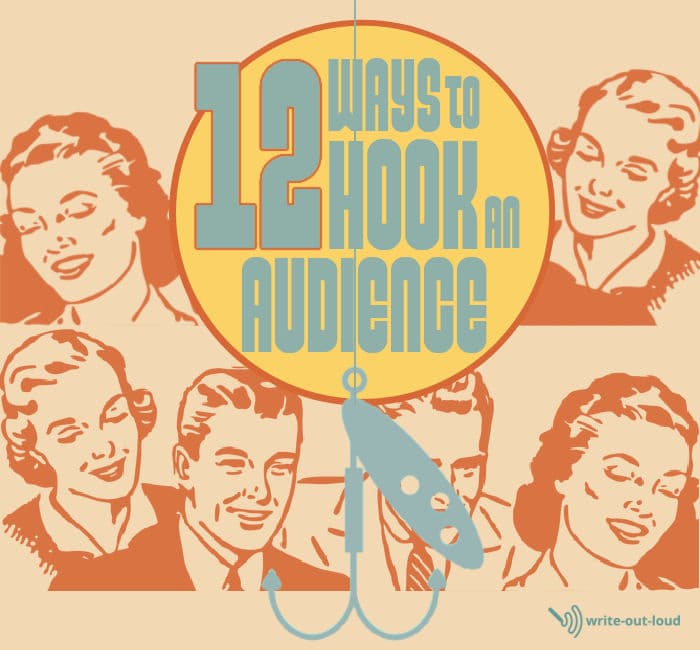
How to choose the right opener for your speech
The better way to make your choice of opener is after you have carefully considered who you are talking to and why you're talking to them.
One size does not fit all. Different audiences will respond differently. If you are giving the same speech multiple times think about what you may need to change to fit.
To work well your opening needs to be aligned with:
- the type of speech you're giving
- your main purpose for giving it
- your target audience and,
- their interests or needs
Both the hook * to catch their attention and your topic must be relevant to them. Unless they're a captive audience, they've come freely to listen to you and they're expecting something of value from you.
How are you going to let them know they're in the right place? Why should they listen? What are they going to get or gain through listening?
Out of all the different ways to open, what attention getter is absolutely the best way?
The only way I know to work out what is best is to go through each of them, and as you do, consider your audience. Make a short list of those you think might work then try them out before making your final choice.
* hook – an opening statement that immediately captures the audience's attention just like a well baited hook on a fishing line catches a fish.
Return to Top
1. Use imagination to create mind pictures
Ask the audience to use their imagination. Get them to build evocative compelling images in their minds. Make them large. Add vibrant color, sound and movement.
For example:
“Let's take a break. Make yourself comfortable. Now close your eyes for a moment. Take a deep breath, and you're there, in the place where you feel the most at ease, the place where all the tensions, all the demands of your normal everyday life disappear. Look around you. See it. Feel it. It's so good, it's perfect."
“Close your eyes. Take a deep breath and a moment to picture in your mind the people dearest to you, the people you feel you could not live without. Now when did you talk to them, or spend real time with them last?"
2. Use an item to build a connection
Choose an image or an object related to your speech, for instance a pair of shoes, to trigger interest and build a connection.
For example, if I were giving a speech on the lives of upper-middle class 19th century women I could open by holding up a pair of ornately decorated kid leather pumps.
“What's the name of the young woman who wore these? Listen. Can you hear the rustle of her silk skirts? And hear her heart beat bom-biddy-bom as the beau of the ball stepped her way? Would he, or wouldn't he ask her to dance?”
3. Ask a 'What if...?' rhetorical question
'What if...?' invites an audience to consider the possibilities of something becoming real. They can be positive somethings or negative, trivial or something that would have a significant impact if it came to pass.
The power of a 'what if...?' rhetorical question as an opener lies in the potency of the images and feelings it triggers. A well-chosen 'what if...?' will immediately have an audience wanting to hear the rest of your speech.
- "What if we don't find a way to successfully manage climate change?"
- "What if we really did solve the affordable housing crisis?"
- "What if questions of race and color ceased to matter?"
- "What if medicines were freely available to everybody who needed them?"
- "What if the person sitting next to you turned, looked into your eyes and said they loved you? Truly. Madly. Deeply."
4. Try a quotation from someone who's impacted your life in some way
To be effective a quotation doesn't have to be the clever quip or snippet of enduring wisdom: a famous quote from a well known person. It's origin could be personal, something someone important in your life said that's remained with you.
For example, my Mother answered all initial wails of outrage, pain or hurt from any of her five children with a command. "Breathe!" That was repeated, interwoven with encouraging asides, until whoever it was, was able to talk clearly and be understood. "It's OK.", she'd say. "Breathe. Come on. You can do it. Breathe. That's it. Keep going. Good."
Or I could use this line from one of my high school reports which read, "...with further maturity she should do well." (Thank you Mr Phillips. Your prediction was right on target.)
Or this from our son aged four as he watched me getting ready for another day of teaching: "When I grow up I'm going to wear pretty dresses and go to school just like you."
5. Use an interesting key fact
Choose an interesting key fact as an attention getting device: one of the most rarely known, or a shocking statistic from the body of your speech to open with.
For example: "Take a guess at what the most powerful and frequently used word is in the English language?
It's not one of those usually thought of candidates. Love? No. Money? Nope. Neither is it any member of your family... Mum, Dad, brother, sister, son, or daughter.
It's a three letter word, so common it's overlooked and taken for granted. 'The'. It's the humble 'the'."
(For more see this BBC article: Is this the most powerful word in the English language?
Or: "Between 2020/21 and 2021/2022, Americans consumed about 11 million metric tons of sugar, up from about 10 million metric tons in 2009/2010. Can you even begin to imagine the size of that sweet white mountain?"
(For more see: US sugar consumption statistics )
6. Share personal stories
Share a personal story related to your specific topic as the beginning of a speech. Done well, it lets the audience know you understand their situation and helps establish your credibility: your right to talk on the subject.
As an example here's the opening of a speech I gave about the impact of suicide on families and friends:
“One fine Spring day I biked home from school and found a policemen guarding our backdoor. Through it came sounds I'll never forget: my quiet Mother screaming. He said, "You can't go in."
I kicked him in the shins and did. It was the 15th of September, three days before my thirteenth birthday and my father was dead. Killed by his own hand. Suicide.”
(If you want to find out more about the speech and read it, it's here: After they're gone . It's an example persuasive speech using the five steps of Monroe's Motivated Sequence.)
7. Rhetorical questions
These are questions that although they are asked, they're never really intended to be answered by anyone other than the person asking them. * Their principal function is to act as a segue, or lead in, to what the person intends to say next. For instance, the first main point of your introduction.
Examples: "What if I were to say to you that there was no such thing as public speaking fear?"
"What do you think the main benefits of being able to speak up in public are?"
* Although there's bound to be someone in your audience who will. Be ready for them, and move on.
8. An empathetic question, aligning yourself with the audience and eliciting a response
These questions bring speaker and audience together, establishing a common ground, a mutual understanding, which is an effective way to ease into a speech. If your question 'works' you'll see heads nodding in agreement.
- "Have you ever experienced the butterflies in your stomach turning into a herd of rampaging elephants, just before you step up to give your presentation?"
- "Have you ever wanted a good day to never end?"
- "How often have you 'lost' your car in the supermarket car park?"
- "How often have you ever wanted to shout, NO? You want me to prepare a new presentation by tomorrow? NO. You want me to stay late, again? NO."
9. It's in the news
Take headlines from what's trending in media you know the audience will be familiar with and see.
Using those that relate to your speech topic as the opening of your speech is a good way to grab the attention of the audience. It shows how relevant and up-to-the-minute the topic is.
For example: "'Death toll soars to 76 in Florida after Hurricane Ian demolished entire communities.' 'Noru became a super typhoon in 6 hours. Scientists say powerful storms are becoming harder to forecast.' 'Hurricane Orlene strengthens into Category 4 storm as it heads toward western Mexico.'
Three front page headlines from CNN just today. Climate change. Let's do what we can."
10. This day in history
If you're giving a speech to celebrate a special birthday or an anniversary, consider using several carefully selected events that occurred on the same day as a speech opening. They could be either funny or serious, depending on the specific purpose of your speech. They're a great way to place the person in a much wider context and often with exalted company.
For example: "What do the 1863 National Thanksgiving Day proclamation by President Abraham Lincoln, National Boyfriend Day, and Gwen Stefani have in common with Joe? Yes, the 3rd of October! It's a great date made better by being Joe's birthday. And we say Gwen is truly privileged to have the same one as him."
11. Issue a challenge
Let the audience know first thing, at the beginning of the speech, what action you expect they'll be able to take by the time your presentation is complete. Then when you come to the final points, repeat the call to action, or challenge, as part of your closing statement.
For example: "I've a challenge for you. That's to sign up for our public speaking course. Right now you may not see yourself doing that. Public speaking? Me? I'd rather have a root canal done, without painkillers. However, by the end of the presentation...well, let's see. There's a first time for everything!"
Use a startling statement, a fact, or a series of facts, to jolt the audience into paying attention.
"Covid. We've had 1.06 million of us die in the US, so far. Today there are nearly 60,00 new cases. More mothers, fathers, friends, colleagues, children – people. People ill. People who might die. So why have we stopped wearing masks?"
For more: Google: Covid stats US
Other speech writing resources
- how to end a speech effectively : explanations with examples showing how to close a speech with impact
- how to write a speech : a detailed guide with examples covering audience analysis, planning, writing oral language, transitions, how to use an outline...
speaking out loud
Subscribe for FREE weekly alerts about what's new For more see speaking out loud

Top 10 popular pages
- Welcome speech
- Demonstration speech topics
- Impromptu speech topic cards
- Thank you quotes
- Impromptu public speaking topics
- Farewell speeches
- Phrases for welcome speeches
- Student council speeches
- Free sample eulogies
From fear to fun in 28 ways
A complete one stop resource to scuttle fear in the best of all possible ways - with laughter.

Useful pages
- Search this site
- About me & Contact
- Free e-course
- Privacy policy
©Copyright 2006-24 www.write-out-loud.com
Designed and built by Clickstream Designs
- College Essay
- Argumentative Essay
- Expository Essay
- Narrative Essay
- Descriptive Essay
- Scholarship Essay
- Admission Essay
- Reflective Essay
- Nursing Essay
- Economics Essay
Assignments
- Term Papers
- Research Papers
- Case Studies
- Dissertation
- Presentation
- Editing Help
- Cheap Essay Writing
- How to Order
Speech Writing
Introduction Speech
Introduction Speech- Tips & Examples
10 min read
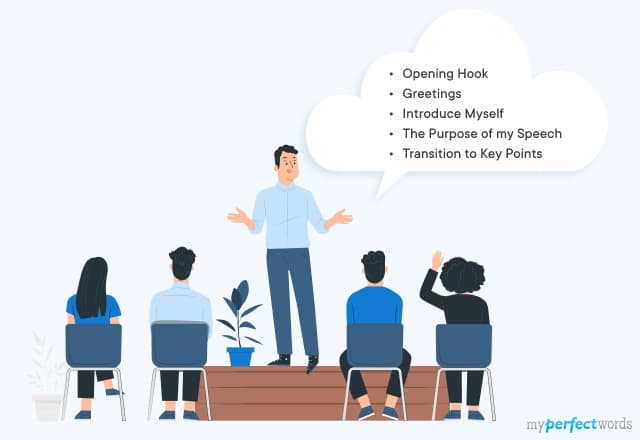
People also read
The 10 Key Steps for Perfect Speech Writing
Understanding Speech Format - Simple Steps for Outlining
How to Start A Speech - 13 Interesting Ideas & Examples
20+ Outstanding Speech Examples for Your Help
Common Types of Speeches that Every Speechwriter Should Know
Good Impromptu Speech Topics for Students
Entertaining Speech Topics for Your Next Debate
Understanding Special Occasion Speech: Types, Steps, Examples and Tips
How to Write A Good Acceptance Speech?
Writing A Presentation Speech In English: Tips And Examples
Commemorative Speech - Writing Guide, Outline & Examples
Farewell Speech | Writing Tips & Examples
How to Write an Extemporaneous Speech? A Step-by-Step Guide
A Graduation Speech Writing Guide with Examples
Introduction speeches are all around us. Whenever we meet a new group of people in formal settings, we have to introduce ourselves. That’s what an introduction speech is all about.
When you're facing a formal audience, your ability to deliver a compelling introductory speech can make a lot of difference. With the correct approach, you can build credibility and connections.
In this blog, we'll take you through the steps to craft an impactful introduction speech. You’ll also get examples and valuable tips to ensure you leave a lasting impression.
So, let's dive in!
- 1. What is an Introduction Speech?
- 2. How to Write an Introduction Speech?
- 3. Introduction Speech Outline
- 4. Introduction Speech Example
- 5. Introduction Speech Ideas
- 6. 7 Tips for Delivering the Best Introduction Speech
What is an Introduction Speech?
An introduction speech, or introductory address, is a brief presentation at the beginning of an event or public speaking engagement. Its primary purpose is to establish a connection with the audience and to introduce yourself or the main speaker.
This type of speech is commonly used in a variety of situations, including:
- Public Speaking: When you step onto a stage to address a large crowd, you start with an introduction to establish your presence and engage the audience.
- Networking Events: When meeting new people in professional or social settings, an effective introduction speech can help you make a memorable first impression.
- Formal Gatherings: From weddings to conferences, introductions set the tone for the event and create a warm and welcoming atmosphere.
In other words, an introduction speech is simply a way to introduce yourself to a crowd of people.
How to Write an Introduction Speech?
Before you can just go and deliver your speech, you need to prepare for it. Writing a speech helps you organize your ideas and prepare your speech effectively.
Here is how to introduce yourself in a speech.
- Know Your Audience
Understanding your audience is crucial. Consider their interests, backgrounds, and expectations to tailor your introduction accordingly.
For instance, the audience members could be your colleagues, new classmates, or various guests depending on the occasion. Understanding your audience will help you decide what they are expecting from you as a speaker.
- Opening the Speech with a Hook
The best speech introduction starts with a hook or opening line that grabs your audience's attention. This could be a surprising fact, a relevant quote, or a thought-provoking question about yourself or the occasion.
- Introduce Yourself
Introduce yourself to the audience. State your name, occupation, or other details relevant to the occasion. You should have mentioned the reason for your speech clearly. It will build your credibility and give the readers reasons to stay with you and read your speech.
- Keep It Concise
So how long is an introduction speech?
Introduction speeches should be brief and to the point. Aim for around 1-2 minutes in most cases. Avoid overloading the introduction with excessive details.
- Highlight Key Points
Mention the most important information that establishes the speaker's credibility or your own qualifications. Write down any relevant achievements, expertise, or credentials to include in your speech. Encourage the audience to connect with you using relatable anecdotes or common interests.
- Rehearse and Edit
Practice your introduction speech to ensure it flows smoothly and stays within the time frame. Edit out any unnecessary information, ensuring it's concise and impactful.
- Tailor for the Occasion
Adjust the tone and content of your introduction speech to match the formality and purpose of the event. What works for a business conference may not be suitable for a casual gathering.
Introduction Speech Outline
To assist you in creating a structured and effective introduction speech, here's a simple speech format that you can follow:
Here is an example outline for a self-introduction speech.
Outline for Self-Introduction Speech
Introduction Speech Example
So if you are wondering what to say in an introduction speech we have you covered! We have compiled introduction speech examples to help you understand how to put your ideas into practice for different scenarios.
Introduction Speech Writing Sample
Short Introduction Speech Sample
Self Introduction Speech for College Students
Introduction Speech about Yourself
Student Presentation Introduction Speech Script
Teacher Introduction Speech
New Employee Self Introduction Speech
Introduction Speech for Chief Guest
Moreover, here is a video example of a self-introduction speech. Watch it to understand how you should deliver your speech:
Want to read examples for other kinds of speeches? Find the best speeches at our blog about speech examples !
What Are Some Famous Introduction Speeches?
Here are the best introduction speeches for students to get inspired:
- Malala Yousafzai's Nobel Peace Prize Acceptance Speech (2014) : Malala's speech upon receiving the Nobel Peace Prize introduced her advocacy for girls' education and youth empowerment globally.
- Elon Musk's Presentation on SpaceX Interplanetary Transport System (2016) : Elon Musk introduced SpaceX's ambitious plans for interplanetary travel, outlining a vision for the future of space exploration.
- Michelle Obama's Democratic National Convention Speech (2008) : Michelle Obama's speech introduced her as a potential First Lady, sharing personal stories and values that resonated with the audience.
- J.K. Rowling's Harvard Commencement Speech (2008) : Rowling's speech introduced themes of failure, imagination, and resilience, drawing from her personal journey as an author and philanthropist.
Introduction Speech Ideas
So now that you’ve understood what an introduction speech is, you may want to write one of your own. So what should you talk about?
The following are some sample introduction speech topics and ideas that can provide an engaging start to a presentation, meeting, or social gathering.
- Personal Story: Share a brief personal story or experience that has shaped you.
- Professional Background: Highlight your career achievements and expertise.
- Hobby or Passion: Discuss a hobby or passion you're enthusiastic about.
- Volunteer Work: Talk about your involvement in volunteer work or community service.
- Travel Adventures: Share anecdotes from your travel adventures.
- Books or Literature: Provide an introduction related to a favorite book, author, or literary work.
- Achievements and Milestones: Highlight significant achievements and milestones in your life or career.
- Cultural Heritage: Explore your cultural heritage and its influence on your identity.
- Social or Environmental Cause: Discuss your dedication to a particular social or environmental cause.
- Future Aspirations: Share your future goals and aspirations.
You can deliver engaging speeches on all kinds of topics. Here is a list of entertaining speech topics to get inspiration.
7 Tips for Delivering the Best Introduction Speech
Now that you know how to write an effective introduction speech, let's focus on the delivery. The way you present your introduction is just as important as the content itself. Here are some valuable tips to ensure you deliver a better introduction speech:
Tip# 1: Maintain Eye Contact
Make eye contact with the audience to establish a connection. This shows confidence and engages your listeners.
Tip# 2: Use Appropriate Body Language
Your body language should convey confidence and warmth. Stand or sit up straight, use open gestures, and avoid fidgeting.
Tip# 3: Mind Your Pace
Speak at a moderate pace, avoiding rapid speech. A well-paced speech is easier to follow and more engaging.
Tip# 4: Avoid Filler Words
Minimize the use of filler words such as "um," "uh," and "like." They can be distracting and detract from your message.
Tip# 5: Be Enthusiastic
Convey enthusiasm about the topic or the speaker. Your energy can be contagious and inspire the audience's interest.
Tip# 6: Practice, Practice, Practice
Rehearse your speech multiple times. Practice in front of a mirror, record yourself or seek feedback from others.
Tip# 7: Be Mindful of Time
Stay within the allocated time for your introduction. Going too long can make your speech too boring for the audience.
Mistakes to Avoid in an Introduction Speech
When crafting and delivering an introduction speech, it's important to avoid common pitfalls that can reduce its impact. Here are some mistakes to watch out for:
- Rambling On: Avoid making the introduction too long. Keep it short and sweet to set the stage without stealing the spotlight.
- Lack of Preparation: Not preparing enough can lead to awkward pauses or losing your train of thought. Practice your speech to feel more confident.
- Using Jargon or Complex Language: Steer clear of technical jargon or complicated language that might confuse the audience. Keep it simple and clear.
- Being Too Generic: A bland introduction can set a dull tone. Make your speech specific to the event and the speaker to keep it engaging.
- Using Inappropriate Humor: Be careful with humor. Avoid jokes that could offend or alienate the audience.
- Overloading with Background Information: Providing too much background information can overwhelm the audience. Offer just enough to give context without bogging down the introduction.
To Conclude,
An introduction speech is more than just a formality. It's an opportunity to engage, inspire, and connect with your audience in a meaningful way.
With the help of this blog, you're well-equipped to shine in various contexts. So, step onto that stage, speak confidently, and captivate your audience from the very first word.
Moreover, you’re not alone in your journey to becoming a confident introducer. If you ever need assistance, you can place a pay to do my essay request and let the experts help you out.
MyPerfectWords.com offers a custom essay service with experienced professionals who can craft tailored introductions, ensuring your speech makes a lasting impact.
Don't hesitate; hire our professional speech writing service to deliver top-quality speeches at your deadline!

Frequently Asked Questions
How long should a speech introduction be.
A speech introduction should be concise, typically lasting about 1 to 2 minutes. It should set the stage, capture the audience's attention, and provide a clear direction for the rest of the speech.
What Is the Best Speech Introduction Greeting?
The best greeting for a speech introduction depends on the formality of the event. Some examples include:
- Formal: "Good morning/afternoon/evening, distinguished guests."
- Semi-formal: "Hello everyone, thank you for being here today."
- Informal: "Hi everyone, thanks for coming."
What Word to Start a Speech?
Starting a speech with an engaging word or phrase can capture the audience's attention. Here are a few speech starting lines:
- "Imagine..." to prompt the audience to visualize something.
- "Today..." to ground the speech in the present moment.
- "Have you ever..." to ask a thought-provoking question.
- "In our lives..." to make a personal connection.
- "Picture this..." to create a vivid mental image.

Write Essay Within 60 Seconds!

Dr. Barbara is a highly experienced writer and author who holds a Ph.D. degree in public health from an Ivy League school. She has worked in the medical field for many years, conducting extensive research on various health topics. Her writing has been featured in several top-tier publications.
Struggling With Your Paper?
Get a custom paper written at
With a FREE Turnitin report, and a 100% money-back guarantee
LIMITED TIME ONLY!
Keep reading

OFFER EXPIRES SOON!

Introduction Speech
Introduction speech generator.
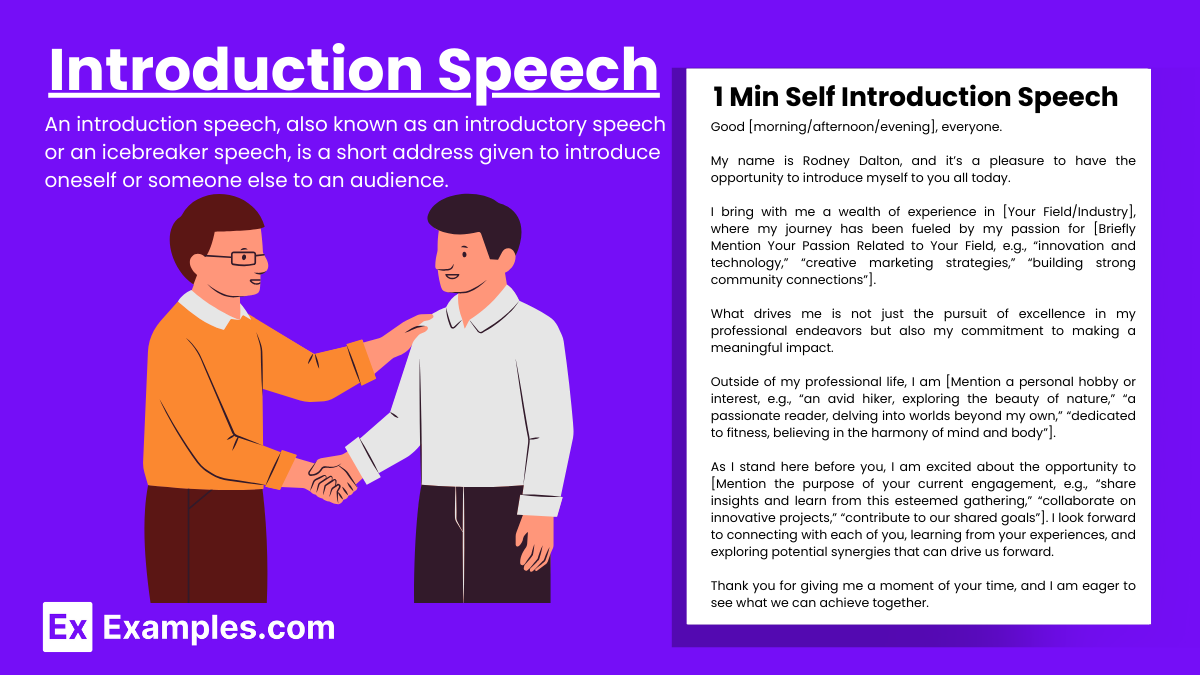
Discover the art of crafting compelling introduction speeches through our comprehensive guide. Whether you’re a beginner or a seasoned speaker, our step-by-step approach simplifies the process. Explore a rich collection of speech examples , tailored to inspire and improve your public speaking skills. Master the nuances of delivering impactful introductions that captivate your audience, using our expertly curated speech examples as your roadmap to success.
What is Introduction Speech?
An introduction speech , also known as an introductory speech or an icebreaker speech, is a short address given to introduce oneself or someone else to an audience. The purpose of an introduction speech is to provide relevant information about the person being introduced, set the tone for the event or presentation, and establish a connection with the audience. This type of speech is commonly used in various settings, such as conferences, meetings, seminars, social events, and classrooms.
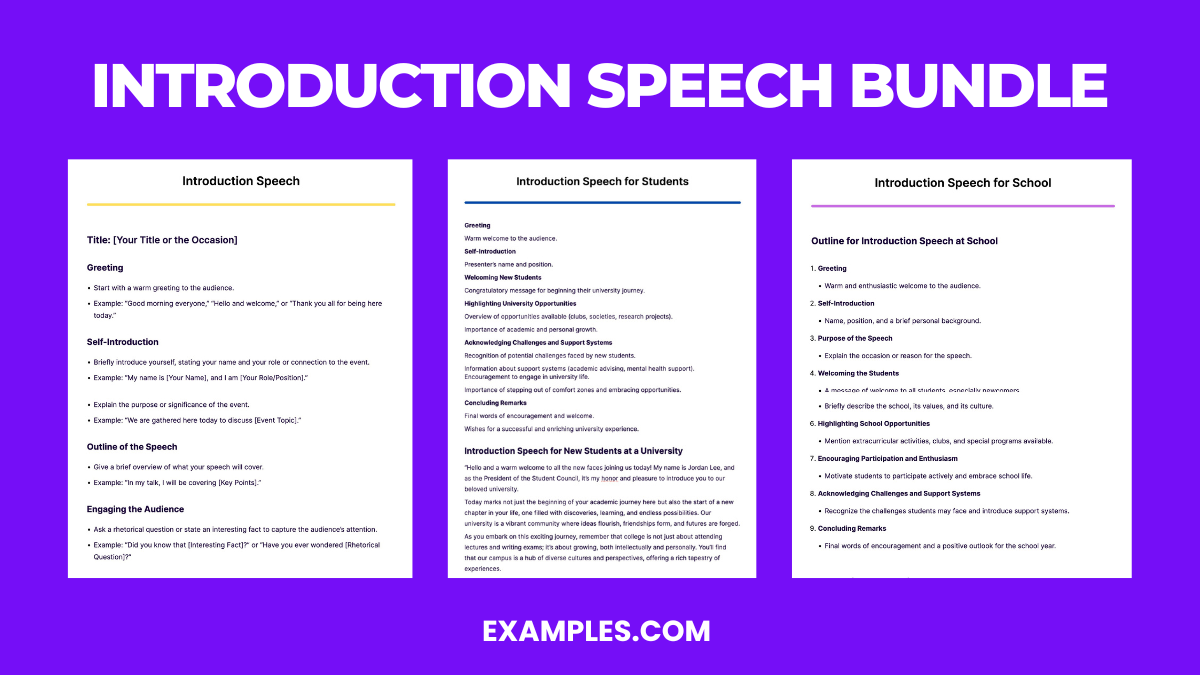
Download Introduction Speech Bundle
A speech can be of any form and used for various functions. It can be a thank-you speech to show one’s gratitude or even an introduction speech to introduce a person (even oneself), product, company, or the like. In these examples, let’s look at different speech examples that seek to introduce.
Introduction Speech Example
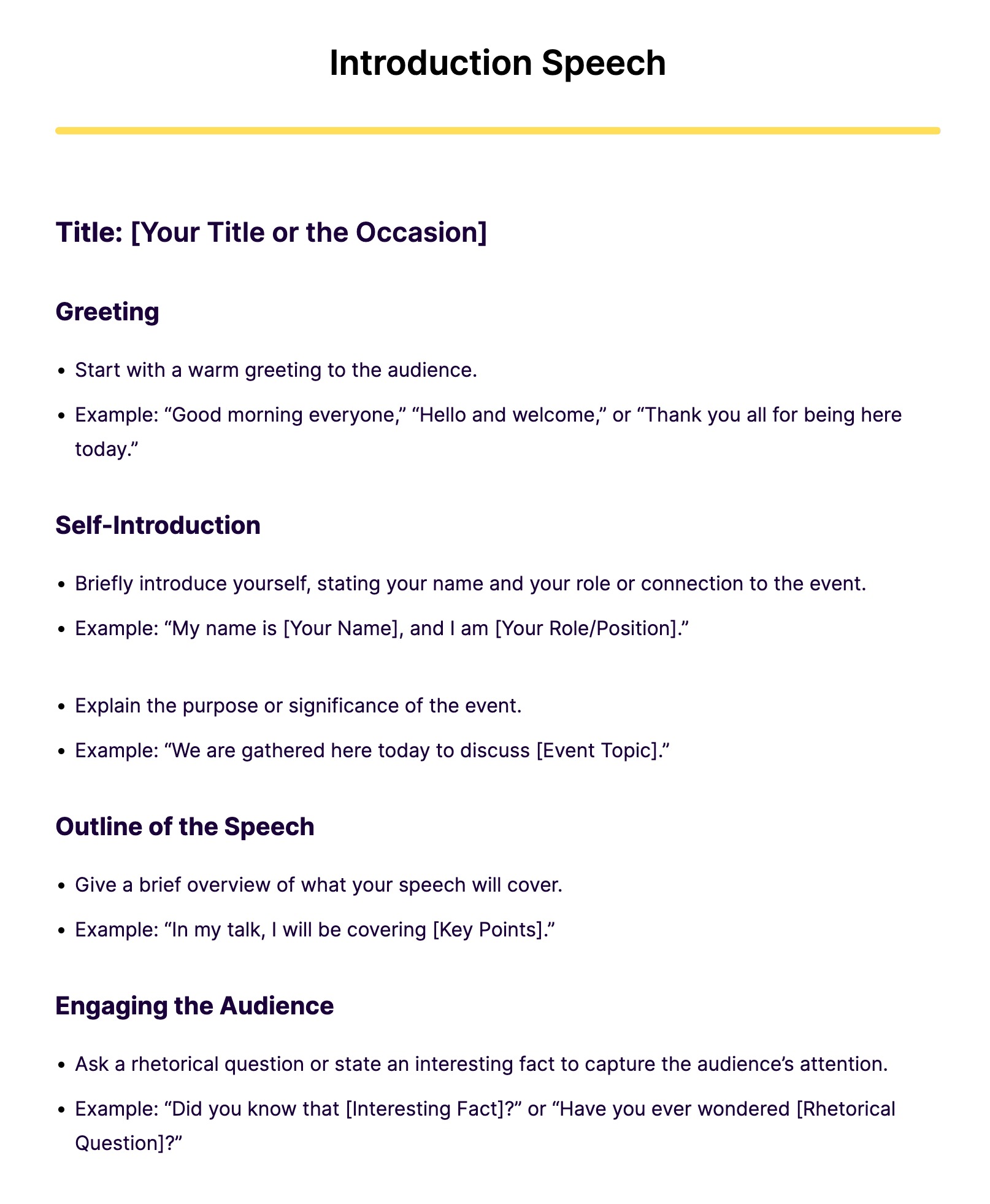
Free Download
Introduction Speech for Students

Introduction Speech for School
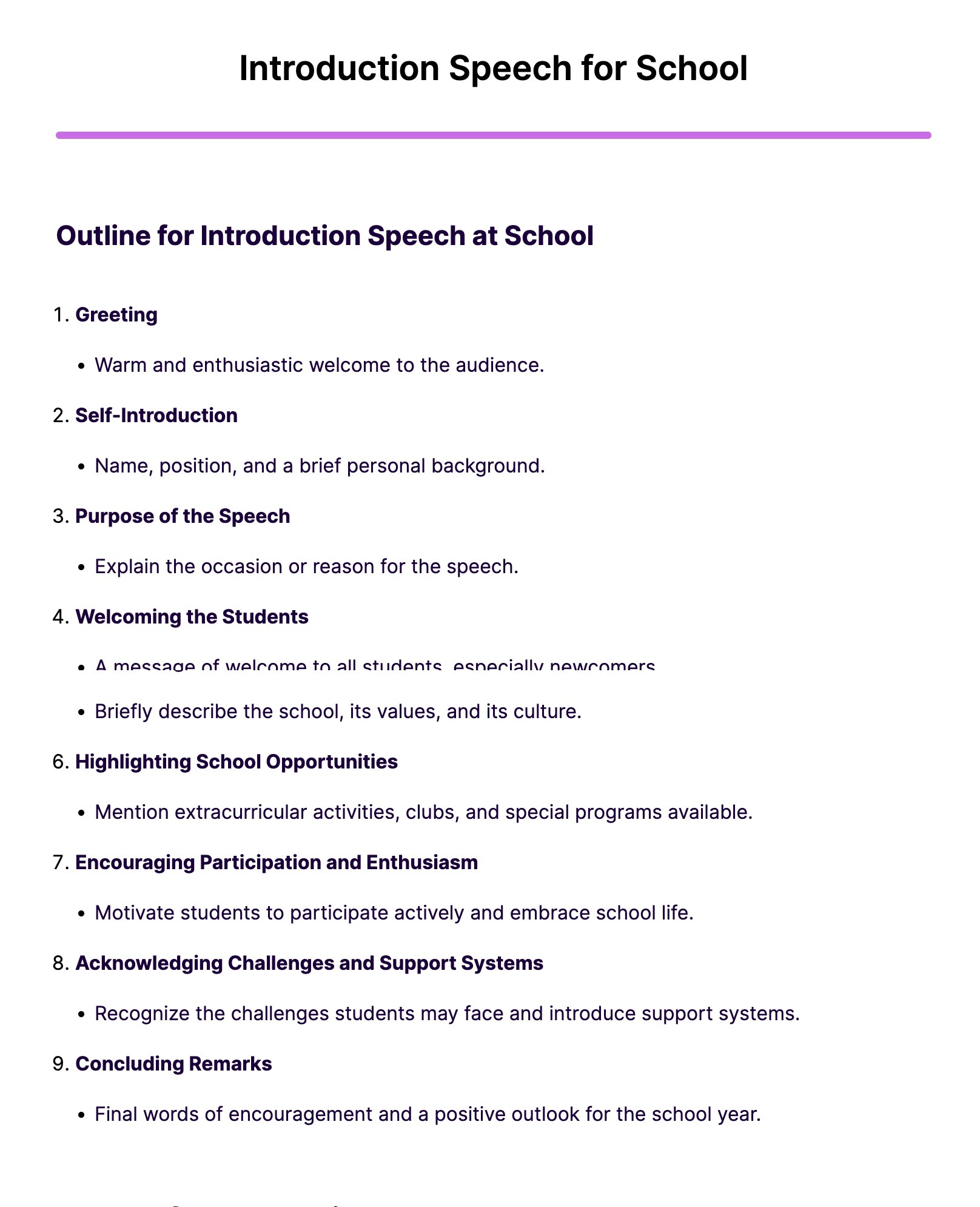
Self-Introduction Sample
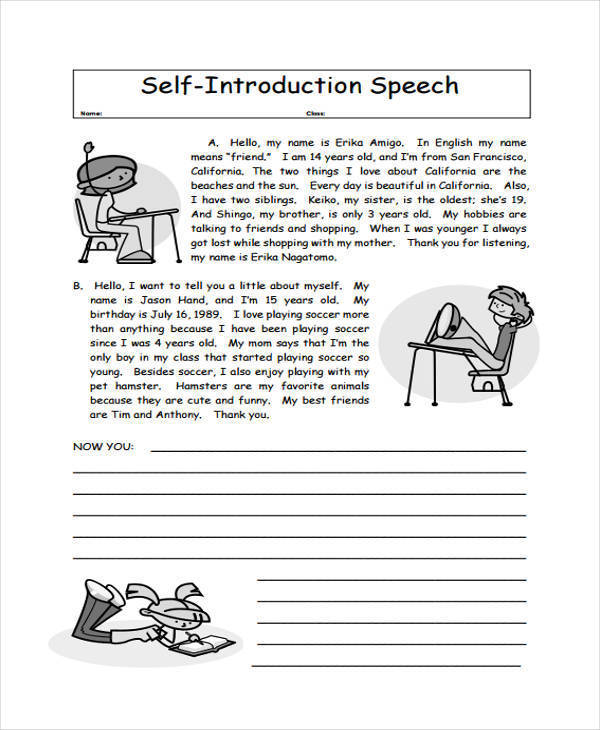
Short Introduction Speech
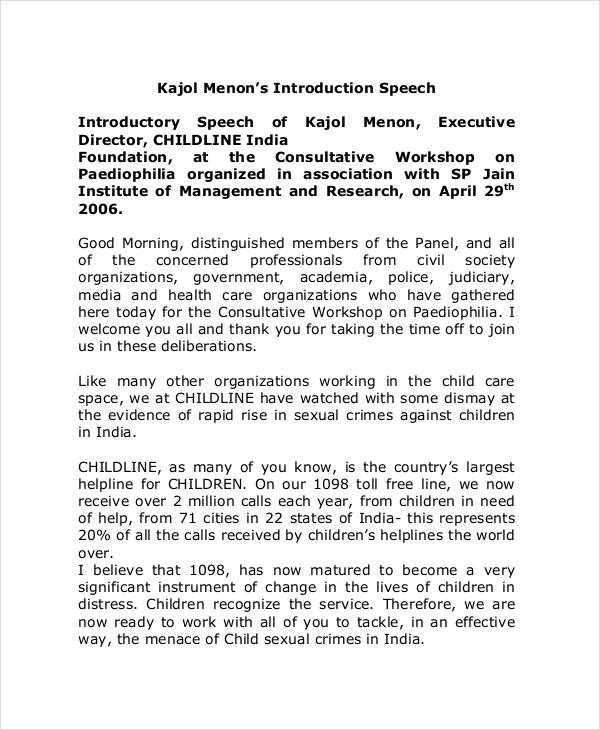
Introduction Speech for Employee
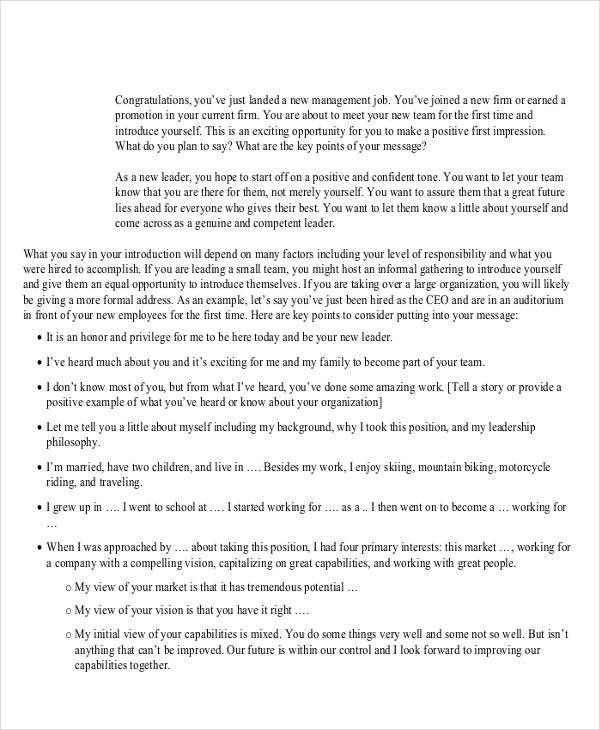
alpinelink.com
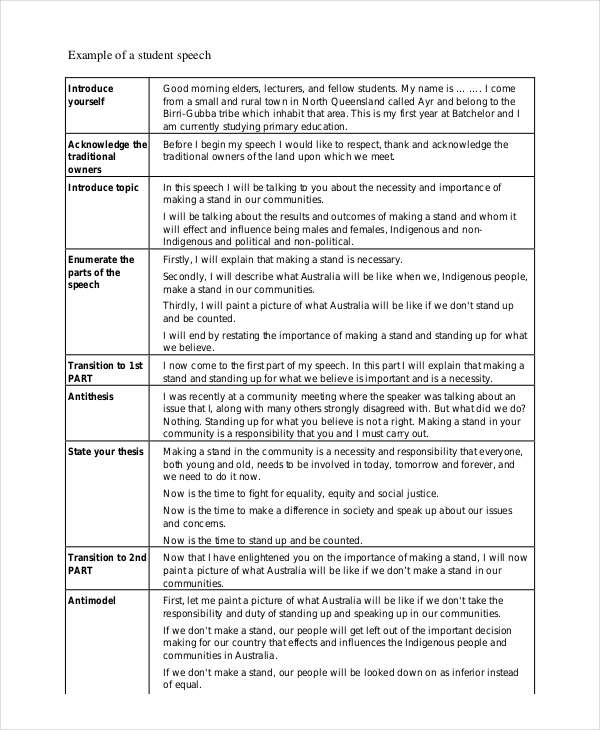
waalc.org.au
Formal Introduction Sample

archive.icann.org
More Introduction Speech Examples and Samples
Self Introduction Speech for Interview Self Introduction Speech for School Students Self Introduction Speech for Middle School Self Introduction Speech for University New Manager Introduction Speech Introduction Speech for an Event Introduction Speech for Freshers Party Introduction Speech for Guest Speaker Introduction Speech for Seminar Introduction Speech for Conference Introduction Speech for Workshop Introduction Speech for Award Ceremony Introduction Speech for Corporate Event Introduction Speech for Team Meeting Introduction Speech for Annual Day Introduction Speech for Webinar Introduction Speech for Cultural Event Introduction Speech for Product Launch Introduction Speech for Training Session Introduction Speech for Charity Event Introduction Speech for Graduation Ceremony Introduction Speech for Farewell Party Introduction Speech for Business Meeting Introduction Speech for School Assembly Introduction Speech for Panel Discussion Introduction Speech for Retirement Party Introduction Speech for Anchoring Introduction Speech for Program
How to Write a Introduction Speech?
Start with a warm and friendly greeting to the audience.
- Example: “Good afternoon, everyone.”
2. Self-Introduction (if introducing yourself)
State your name and your role or position.
Example : “My name is [Your Name], and I am [your position, e.g., ‘the new marketing manager’].”
3. Purpose of the Speech
Explain why you are speaking and the context of the event.
Example : “I’m here today to introduce our guest speaker, [Speaker’s Name].”
4. Background Information
Provide relevant details about the person being introduced, such as their qualifications and achievements.
Example : “[Speaker’s Name] is a renowned expert in [field], with over [number] years of experience.”
5. Significance and Credentials
Highlight why the person is important and their qualifications to speak on the topic.
Example : “[Speaker’s Name] has received numerous awards, including [specific award].”
6. Personal Touch:
Add a personal anecdote or a light-hearted comment to make the introduction engaging.
Example : “When [Speaker’s Name] is not busy revolutionizing the industry, they enjoy hiking and cooking gourmet meals.”
7. Conclusion
Wrap up the introduction by reiterating the importance of the person or the event.
Example : “Please join me in welcoming [Speaker’s Name].”
8. Transition
Smoothly transition to the next part of the event or hand over to the person being introduced.
Example : “Without further ado, here is [Speaker’s Name].”
Tips For Introduction Speech
Start with a Greeting:
- Begin with a warm, friendly greeting.
Introduce Yourself:
- State your name and your role or connection.
- Example: “I’m [Your Name], [Speaker’s Name]’s colleague.”
State the Purpose:
- Explain why you’re speaking and the context.
- Example: “I’m here to introduce our guest speaker, [Speaker’s Name].”
Highlight Key Details:
- Share relevant background information and achievements.
- Example: “[Speaker’s Name] has over 20 years of experience in [field].”
Add a Personal Touch:
- Include a personal anecdote or light-hearted comment.
- Example: “Outside of work, [Speaker’s Name] enjoys hiking and gourmet cooking.”
Summarize Significance:
- Emphasize why the person is important.
- Example: “[Speaker’s Name]’s innovative work has set new industry standards.”
Conclude and Transition:
- Wrap up and smoothly transition to the speaker.
- Example: “Please join me in welcoming [Speaker’s Name].”
FAQ’s
What should an introduction speech include.
Include the speaker’s name, credentials, achievements, and relevance to the topic or event.
How long should an introduction speech be?
An introduction speech should typically last between 1 to 3 minutes, keeping it concise and engaging.
How can I prepare for an introduction speech?
Research the speaker thoroughly, practice your speech, and time yourself to ensure it’s concise and engaging.
How do I address the audience in an introduction speech?
Address the audience formally, using appropriate greetings such as “Ladies and Gentlemen” or “Distinguished Guests.”
Should I mention the speaker’s personal life?
Only mention personal details if they are relevant and appropriate for the context and audience.
How can I make the introduction speech engaging?
Share interesting and relevant facts, anecdotes, or achievements about the speaker that connect with the audience.
What tone should I use in an introduction speech?
Use a respectful, enthusiastic, and welcoming tone to create a positive atmosphere.
How can I start an introduction speech?
Begin with a compelling opening, such as a quote, anecdote, or interesting fact about the speaker.
Why is an introduction speech important?
It sets the tone for the speaker, builds credibility, and engages the audience, preparing them for the main presentation.
What mistakes should I avoid in an introduction speech?
Avoid overly long speeches, irrelevant details, mispronouncing names, and using a monotone voice.
Text prompt
- Instructive
- Professional
Write an Introduction Speech for a guest speaker at a conference.
Create an Introduction Speech for a new teacher at school.

Want to create or adapt books like this? Learn more about how Pressbooks supports open publishing practices.
9.1 The Importance of an Introduction
Learning objectives.
- Explain the general length of an introduction.
- List and explain the five basic functions of an introduction.
- Understand how to use three factors of credibility in an introduction.

Brian Indrelunas – enter at your own risk – CC BY-NC 2.0.
The introduction for a speech is generally only 10 to 15 percent of the entire time the speaker will spend speaking. This means that if your speech is to be five minutes long, your introduction should be no more than forty-five seconds. If your speech is to be ten minutes long, then your introduction should be no more than a minute and a half. Unfortunately, that 10 to 15 percent of your speech can either make your audience interested in what you have to say or cause them to tune out before you’ve really gotten started. Overall, a good introduction should serve five functions. Let’s examine each of these.
Gain Audience Attention and Interest
The first major purpose of an introduction is to gain your audience’s attention and make them interested in what you have to say. One of the biggest mistakes that novice speakers make is to assume that people will naturally listen because the speaker is speaking. While many audiences may be polite and not talk while you’re speaking, actually getting them to listen to what you are saying is a completely different challenge. Let’s face it—we’ve all tuned someone out at some point because we weren’t interested in what they had to say. If you do not get the audience’s attention at the outset, it will only become more difficult to do so as you continue speaking. We’ll talk about some strategies for grabbing an audience’s attention later on in this chapter.
State the Purpose of Your Speech
The second major function of an introduction is to reveal the purpose of your speech to your audience. Have you ever sat through a speech wondering what the basic point was? Have you ever come away after a speech and had no idea what the speaker was talking about? An introduction is important because it forces the speaker to be mindfully aware of explaining the topic of the speech to the audience. If the speaker doesn’t know what her or his topic is and cannot convey that topic to the audience, then we’ve got really big problems! Robert Cavett, the founder of the National Speaker’s Association, used the analogy of a preacher giving a sermon when he noted, “When it’s foggy in the pulpit, it’s cloudy in the pews.”
As we discussed in Chapter 6 “Finding a Purpose and Selecting a Topic” , the specific purpose is the one idea you want your audience to remember when you are finished with your speech. Your specific purpose is the rudder that guides your research, organization, and development of main points. The more clearly focused your purpose is, the easier your task will be in developing your speech. In addition, a clear purpose provides the audience with a single, simple idea to remember even if they daydream during the body of your speech. To develop a specific purpose, you should complete the following sentence: “I want my audience to understand that…” Notice that your specific speech purpose is phrased in terms of expected audience responses, not in terms of your own perspective.
Establish Credibility
One of the most researched areas within the field of communication has been Aristotle’s concept of ethos or credibility. First, and foremost, the concept of credibility must be understood as a perception of receivers. You may be the most competent, caring, and trustworthy speaker in the world on a given topic, but if your audience does not perceive you as credible, then your expertise and passion will not matter. As public speakers, we need to make sure that we explain to our audiences why we are credible speakers on a given topic.
James C. McCroskey and Jason J. Teven have conducted extensive research on credibility and have determined that an individual’s credibility is composed of three factors: competence, trustworthiness, and caring/goodwill (McCroskey & Teven, 1999). Competence is the degree to which a speaker is perceived to be knowledgeable or expert in a given subject by an audience member. Some individuals are given expert status because of positions they hold in society. For example, Dr. Regina Benjamin, the US Surgeon General, is expected to be competent in matters related to health and wellness as a result of being the United States’ top physician.
Figure 9.1 Regina Benjamin
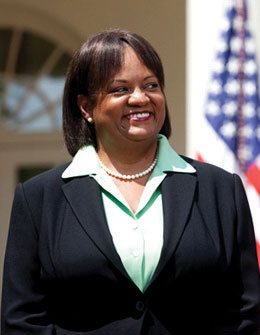
Source: Photo by Lawrence Jackson, White House photographer, http://www.whitehouse.gov/assets/images/surgeon_general-0075.jpg .
But what if you do not possess a fancy title that lends itself to established competence? You need to explain to the audience why you are competent to speak on your topic. Keep in mind that even well-known speakers are not perceived as universally credible. US Surgeon General Regina Benjamin may be seen as competent on health and wellness issues, but may not be seen as a competent speaker on trends in Latin American music or different ways to cook summer squash. Like well-known speakers, you will need to establish your credibility on each topic you address, so establishing your competence about the energy efficiency of furnace systems during your informative speech does not automatically mean you will be seen as competent on the topic of organ donation for your persuasive speech.
The second factor of credibility noted by McCroskey and Teven is trustworthiness , or the degree to which an audience member perceives a speaker as honest. Nothing will turn an audience against a speaker faster than if the audience believes the speaker is lying. When an audience does not perceive a speaker as trustworthy, the information coming out of the speaker’s mouth is automatically perceived as deceitful. The speaker could be 100 percent honest, but the audience will still find the information suspect. For example, in the summer of 2009, many Democratic members of Congress attempted to hold public town-hall meetings about health care. For a range of reasons, many of the people who attended these town-hall meetings refused to let their elected officials actually speak because the audiences were convinced that the Congressmen and Congresswomen were lying.
In these situations, where a speaker is in front of a very hostile audience, there is little a speaker can do to reestablish that sense of trustworthiness. These public town-hall meetings became screaming matches between the riled-up audiences and the congressional representatives. Some police departments actually ended up having to escort the representatives from the buildings because they feared for their safety. Check out this video from CNN.com to see what some of these events actually looked like: http://www.cnn.com/video/#/video/bestoftv/2009/08/07/ldt.sylvester.town.hall.cnn?iref=videosearch . We hope that you will not be in physical danger when you speak to your classmates or in other settings, but these incidents serve to underscore how important speaker trustworthiness is across speaking contexts.
Caring/goodwill is the final factor of credibility noted by McCroskey and Teven. Caring/goodwill refers to the degree to which an audience member perceives a speaker as caring about the audience member. As noted by Wrench, McCroskey, and Richmond, “If a receiver does not believe that a source has the best intentions in mind for the receiver, the receiver will not see the source as credible. Simply put, we are going to listen to people who we think truly care for us and are looking out for our welfare” (Wrench, McCroskey & Richmond, 2008). As a speaker, then, you need to establish that your information is being presented because you care about your audience and are not just trying to manipulate them. We should note that research has indicated that caring/goodwill is the most important factor of credibility. This means that if an audience believes that a speaker truly cares about the audience’s best interests, the audience may overlook some competence and trust issues.
Provide Reasons to Listen
The fourth major function of an introduction is to establish a connection between the speaker and the audience, and one of the most effective means of establishing a connection with your audience is to provide them with reasons why they should listen to your speech. The idea of establishing a connection is an extension of the notion of caring/goodwill. In the chapters on Language and Speech Delivery, we’ll spend a lot more time talking about how you can establish a good relationship with your audience. However, this relationship starts the moment you step to the front of the room to start speaking.
Instead of assuming the audience will make their own connections to your material, you should explicitly state how your information might be useful to your audience. Tell them directly how they might use your information themselves. It is not enough for you alone to be interested in your topic. You need to build a bridge to the audience by explicitly connecting your topic to their possible needs.
Preview Main Ideas
The last major function of an introduction is to preview the main ideas that your speech will discuss. A preview establishes the direction your speech will take. We sometimes call this process signposting because you’re establishing signs for audience members to look for while you’re speaking. In the most basic speech format, speakers generally have three to five major points they plan on making. During the preview, a speaker outlines what these points will be, which demonstrates to the audience that the speaker is organized.
A study by Baker found that individuals who were unorganized while speaking were perceived as less credible than those individuals who were organized (Baker, 1965). Having a solid preview of the information contained within one’s speech and then following that preview will definitely help a speaker’s credibility. It also helps your audience keep track of where you are if they momentarily daydream or get distracted.
Key Takeaways
- Introductions are only 10–15 percent of one’s speech, so speakers need to make sure they think through the entire introduction to ensure that they will capture an audience. During an introduction, speakers attempt to impart the general and specific purpose of a speech while making their audience members interested in the speech topic, establishing their own credibility, and providing the audience with a preview of the speech structure.
- A speaker’s perceived credibility is a combination of competence, trustworthiness, and caring/goodwill. Research has shown that caring/goodwill is probably the most important factor of credibility because audiences want to know that a speaker has their best interests at heart. At the same time, speakers should strive to be both competent and honest while speaking.
- What are the five basic functions of an introduction? Discuss with your classmates which purpose you think is the most important. Why?
- Why is establishing a relationship with one’s audience important? How do you plan on establishing a relationship with your audience during your next speech?
- Of the three factors of credibility, which do you think is going to be hardest to establish with your peers during your next speech? Why? What can you do to enhance your peers’ perception of your credibility?
Baker, E. E. (1965). The immediate effects of perceived speaker disorganization on speaker credibility and audience attitude change in persuasive speaking. Western Speech, 29 , 148–161.
McCroskey, J. C., & Teven, J. J. (1999). Goodwill: A reexamination of the construct and its measurement. Communication Monographs, 66 , 90–103.
Wrench, J. S., McCroskey, J. C., & Richmond, V. P. (2008). Human communication in everyday life: Explanations and applications . Boston, MA: Allyn & Bacon, pp. 33–34.
Stand up, Speak out Copyright © 2016 by University of Minnesota is licensed under a Creative Commons Attribution-NonCommercial-ShareAlike 4.0 International License , except where otherwise noted.
Share This Book

IMAGES
VIDEO
COMMENTS
Convention presentation. In a speech of introduction you should be sure to _____. a. explain why the speaker is famous, why he/she was chosen to speak here, and the topic of speech. b. explain why the speaker is qualified, why the audience should listen, or care about topic, and …
If you are preparing a speech of introduction, you should -pronounce the speaker's name correctly. -make certain that your remarks are completely accurate. Ellie will introduce a …
A speech introduction should be concise, typically lasting about 1 to 2 minutes. It should set the stage, capture the audience's attention, and provide a clear direction for the rest of the speech. What Is the Best Speech Introduction …
6 Debate Introduction Speech Samples. Standing on stage with every eye fixed on you can make your heart race. The success of your debate starts during those opening …
An introduction speech should typically last between 1 to 3 minutes, keeping it concise and engaging. How can I prepare for an introduction speech? Research the speaker thoroughly, practice your speech, and time …
During an introduction, speakers attempt to impart the general and specific purpose of a speech while making their audience members interested in the speech topic, establishing their own credibility, and providing the audience with …
A good introduction needs to get the audience’s attention, state the topic, make the topic relatable, establish credibility, and preview the main points. Introductions should be …